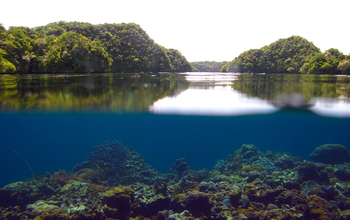 Though ocean acidification and corals have been a concern, not all coral reefs are at risk. Instead, some thrive as they have absorbed atmospheric carbon dioxide (CO2) released by the burning of fossil fuels.
Though ocean acidification and corals have been a concern, not all coral reefs are at risk. Instead, some thrive as they have absorbed atmospheric carbon dioxide (CO2) released by the burning of fossil fuels. In ocean acidification, the CO2 reacts with water molecules, lowering ocean pH (making it more acidic), and that process also removes carbonate, an essential ingredient needed by corals and other organisms to build their skeletons and shells.
World Oceans Day today has meant new questions about ocean acidification, which threatens coral reef ecosystems worldwide - but not all reefs.
One such place is Palau, an archipelago in the far western Pacific Ocean. The tropical, turquoise waters of Palau's Rock Islands are naturally more acidic due to a combination of biological activity and the long residence time of seawater in their maze of lagoons and inlets. Seawater pH within the Rock Island lagoons is as low now as the open ocean is projected to reach as a result of ocean acidification near the end of this century. A new study led by scientists at the Woods Hole Oceanographic Institution (WHOI) found that coral reefs in Palau seem to be defying the odds, showing none of the predicted responses to low pH except for an increase in bio-erosion--the physical breakdown of coral skeletons by boring organisms such as mollusks and worms.
Experiments measuring corals' responses to a variety of low pH conditions have shown a range of negative effects, such as fewer varieties of corals, more algae growth, lower rates of calcium carbonate production (growth), and juvenile corals that have difficulty constructing skeletons.
"Surprisingly, in Palau where the pH is lowest, we see a coral community that hosts more species and has greater coral cover than in the sites where pH is normal," says Anne Cohen, co-author of a new paper in Science Advances. "That's not to say the coral community is thriving because of the low pH, rather it is thriving despite the low pH, and we need to understand how."
The riddle of resilience
How do Palau's low pH reefs thrive despite significantly higher levels of bio-erosion? No one knows, nor is it known why conditions created by ocean acidification seem to favor bio-eroding organisms.
One hypothesis, that skeletons grown under more acidic conditions are less dense, making them easier for bio-eroding organisms to penetrate, is not the case on Palau, because there isn't a correlation between skeletal density and pH.
Though coral reefs cover less than one percent of the ocean, these diverse ecosystems are home to at least a quarter of all marine life. In addition to sustaining fisheries that feed hundreds of millions of people around the world, coral reefs protect thousands of acres of coastlines from waves, storms and tsunamis.
The Dalio Foundation, Inc., The Tiffany&Co. Foundation, The Nature Conservancy and the WHOI Access to the Sea Fund provided additional funding for this work.





Comments